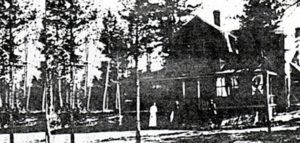The following story by William Marvel is reprinted from the Conway Daily Sun.
Conway—September 21, 2020—George N. Kennett, of Madison, made his living driving people, and on the afternoon of Sept. 28, 1916, he picked up a passenger at an isolated cottage on the south shore of Ossipee Lake. Frederick L. Small emerged from the house in business attire, shouting a goodbye over his shoulder as he closed the door, and climbed into Kennett’s car with a valise. Soon thereafter, Kennett dropped him at the West Ossipee rail station, to catch the Boston train.
Around midnight the cottage erupted in flames and burned to the ground. Florence Small was found in the wreckage, with most of her body incinerated, but when the floor collapsed she fell into the cellar. Her head landed in a corner full of water, where it was preserved from the fire and found with a fractured skull and a rope still tied around the neck. One report said there was also a bullet in her head.
Small came home at the news, and was promptly arrested for murder. He posted a reward for information about the intruder he insisted had done the deed, but prosecutors theorized that Small had rigged an electrical contraption to start the fire hours after he left. Just after Christmas his trial began in the old Carroll County courtroom.
Small was born in a suburb of Portland in January of 1867. When he was 18, his father posted a newspaper ad announcing that he would no longer be responsible for his son’s debts. Small married a girl named Nettie Davis and opened a grocery store at 991 Congress St., but in March of 1891 Nettie died unexpectedly at 22, whereupon Small closed the store and sold off the inventory.
Years later, he surfaced west of Boston with another wife. From there he moved to New York City, where he started a stock brokerage firm with Col. Henry W. Freeman of the New Jersey National Guard. The business was secured by Freeman’s reputation, but it went broke in 1906, and two years later, both Freeman and Small were indicted for grand larceny over missing investment money. Freeman swore he knew nothing about it.
That indictment was resolved somehow, but six months later Small’s name was plastered across the front pages of national newspapers. He was then living in Boston, where he filed a half-million-dollar lawsuit for alienation of affections against Arthur H. Soden, who owned the Boston National Baseball Club and the New York Giants. According to Small, the 65-year-old Soden had “mesmerized” Laura Small, and had written her a series of letters that her husband found. Apparently Small had also intercepted some of Laura’s letters to Soden, and the courtroom was packed on the day those letters were scheduled to be read.

Ossipee Lake cottage where Florence Small was murdered. Photo: NY Daily News
Soden pleaded complete innocence, although Small said he had obtained an uncontested divorce naming Soden as co-respondent. Mrs. Soden seemed to believe her husband, and their marriage survived, but Small evidently obtained a $10,000 settlement. At the time of the trial, no one knew where Laura Small was, but despite testifying that he was divorced Small continued to describe himself as married more than a year later.
He was still selling stocks and bonds in Boston when, late in 1911, he married Florence Aileen Curry, the 32-year-old daughter of a steamship captain. He bought the cottage on Ossipee Lake with cash in August of 1914, but he apparently began thinking about ending this marriage with a profit, as he had the last. In January of 1916 he bought a $20,000 life insurance policy for himself and Florence, with each as the other’s beneficiary. He also insured the cottage, listing every item in it except a revolver and Florence’s jewelry, which was worth $6,000.
All this looked very suspicious. The prosecutor took no chances, however, and aroused the jurors’ prejudice by showing them Florence’s head — driving her mother from the courtroom in the process. Newspaper reporters did not specify how it was displayed. Presumably they didn’t pass it around like a cabbage, but it did the trick. After a brief deliberation the panel found Small guilty and recommended the death penalty, which Judge John Kivel imposed. After sitting in the prison at Concord for a year, Small went to the gallows on Jan. 15, 1918.
William Marvel lives in South Conway.
The Florence Small murder was the subject of Ossipee Lake Alliance’s “Ghost of Ossipee Lake” event in 2003. Read about it in our Autumn 2003 newsletter. We also published a 2016 news story about the centennial anniversary of the murder. Janice Petrie’s book, “Perfection to a Fault,” which detailed accounts of Florence Small’s ghost, remains in print and is available from Amazon.
